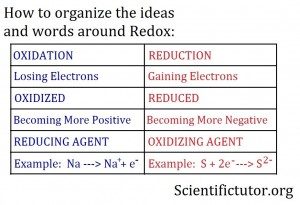Scientific Tutor
Chem – Determining Oxidation Versus Reduction
How do you determine an oxidation versus a reduction?
The next step in this chapter is to now use these redox rules and apply them to chemical equations. You still treat each compound, molecule, or element you come across in the same way as the redox rules in the previous section. However, you will start to notice that some elements will change redox numbers as they go from the reactants side to the products side. This change in redox number is what you are looking for. IF AND ELEMENT LOSES ELECTRONS IT HAS BEEN OXIDIZED OR UNDERWENT OXIDATION. This means it will increase its redox number. Another way to state that is the element increases in charge (becomes more positive or closer to a positive charge). IF AN ELEMENT GAINS ELECTRONS IT HAS BEEN REDUCED OR UNDERWENT REDUCTION. This means it will decrease its redox number. Another way to state that is the element decreases in charge (becomes more negative or closer to a negative). The picture below summarizes this text above.
What is the purpose of assigning redox numbers to the elements in a chemical equation?
The purpose of assigning redox numbers to all elements in chemical equations is to determine which elements are undergoing oxidation and which elements are undergoing reduction.
Another handy tip to remember these is the word OIL RIG. It stands for Oxidation is a Loss of electrons and Reduction is a Gain of electrons.
Examples: Which element is undergoing oxidation? Which element is undergoing reduction? (Use Redox Rules to solve these.)
3 Na(s) + CrCl3(s) ——> 3 NaCl(aq) + Cr(s)
Answer: Na is undergoing OXIDATION. Cr is undergoing REDUCTION.
CH4(g) + 2 O2(g) ——> CO2(g) + 2 H2O(g)
Answer: Carbon is undergoing OXIDATION. Oxygen is undergoing REDUCTION.
VIDEO Determining Oxidation Versus Reduction Demonstrated Example 1: Which element is undergoing oxidation? Which element is undergoing reduction? (Use Redox Rules to help you solve.)
2 H2CO3(aq) ——> 4 H+(aq) + 2 C(s) + 3 O2(g)
Step 1: How do I start?
Answer: Give all the elements their redox numbers on each side of the equation.
Reactants (H = +1, C = +4, O = -2) Products (H = +1, C = zero, O = zero)
Step 2: What elements are changing in redox number as they go from reactants to products?
Answer: Carbon and Oxygen (C +4 —> C zero) (O -2 —> O zero)
Step 3: Which one is undergoing oxidation?
Answer: Oxygen, because it is becoming more positive (losing 2 electrons)
Step 4: Which one is undergoing oxidation?
Answer: Carbon, because it is becoming more negative (gaining 4 electrons)
COMPLETE ANSWER: Oxygen is undergoing OXIDATION. Carbon is undergoing REDUCTION.
VIDEO Determining Oxidation Versus Reduction Demonstrated Example 2: Which element is undergoing oxidation? Which element is undergoing reduction? (Use Redox Rules to help you solve.)
6 Cu(s) + Fe3N2(s) ——> 2 Cu3N(s) + 3 Fe(s)
Step 1: How do I start?
Answer: Give all the elements their redox numbers on each side of the equation.
Reactants (Cu = zero, Fe = +2, N = -3) Products (Cu = +1, Fe = zero, N = -3)
Step 2: What elements are changing in redox number as they go from reactants to products?
Answer: Copper and Iron (Cu zero —> Cu +1) (Fe +2 —> Fe zero)
Step 3: Which is undergoing oxidation?
Answer: Copper, because it is becoming more positive (losing 1 electron)
Step 4: Which is undergoing reduction?
Answer: Iron, because it is becoming more negative (gaining 2 electrons)
COMPLETE ANSWER: Copper is undergoing OXIDATION. Iron is undergoing REDUCTION.
PRACTICE PROBLEMS: Which element is undergoing oxidation? Which element is undergoing reduction? (Use Redox Rules to help you solve. You might also want to use the oxidation versus reduction table.)
| 2 H2O(g) <—-> 2 H2(g) + O2(g) |
| Answer: Oxygen = Oxidation, Hydrogen = Reduction |
| 6 Ag(s) + Ca3(PO4)2(s) <——> 3 Ca(aq) + 2 Ag3PO4(s) |
| Answer: Silver = Oxidation, Calcium = Reduction |
| 2 N2O3(g) <——> 2 N2(g) + 3 O2(g) |
| Answer: Nitrogen = Reduction, Oxygen = Oxidation |
| 2 C4H10(l) + 13 O2(g) <——> 8 CO2(g) + 10 H2O(g) |
| Answer: Oxygen = Reduction, Carbon = Oxidation |
| 2 Fe(NO3)3(aq) + 3 Be(s) ——> 3 Be(NO3)2(s) + 2 Fe(s) |
| Answer: Iron = Reduction, Beryllium = Oxidation |
Just in case, we also want to make sure you can answer redox problems by identifying the agents…. AGENTS

